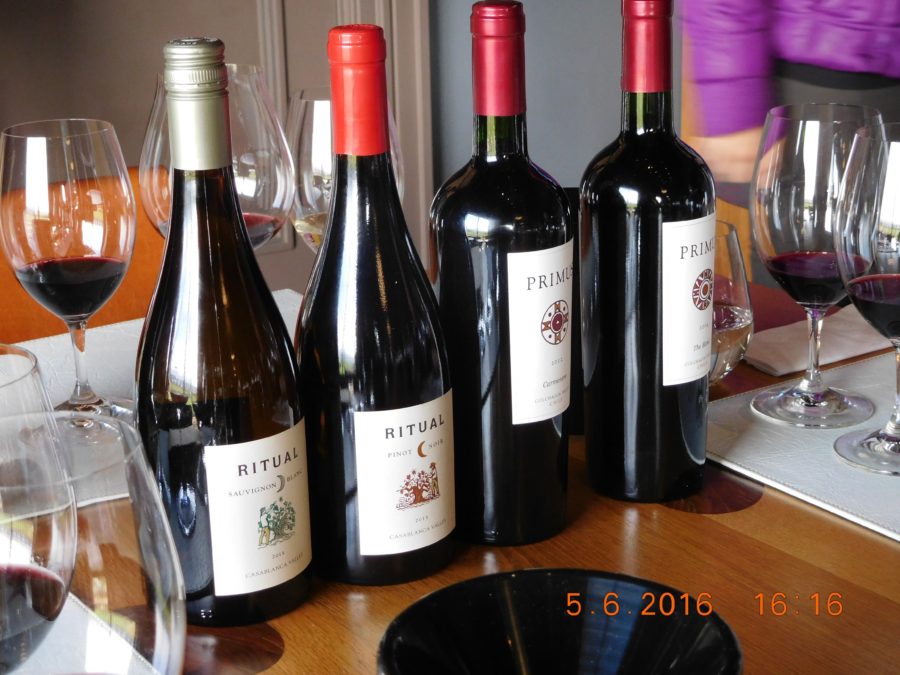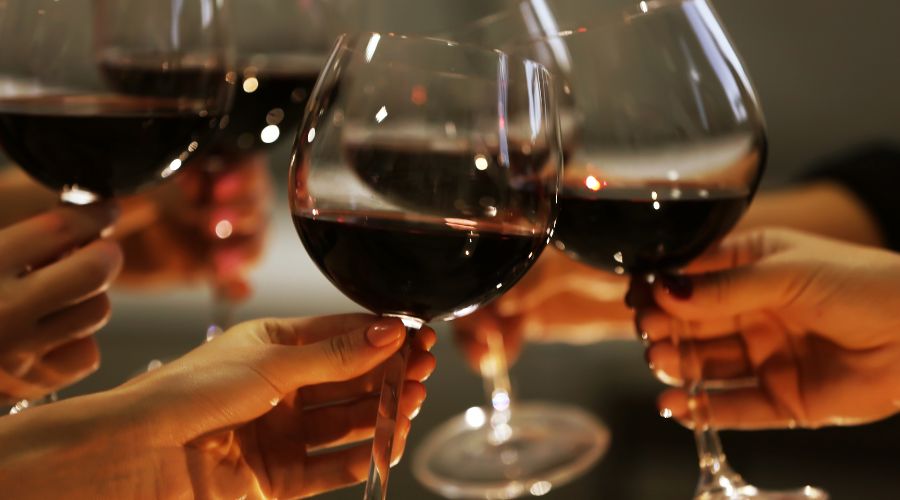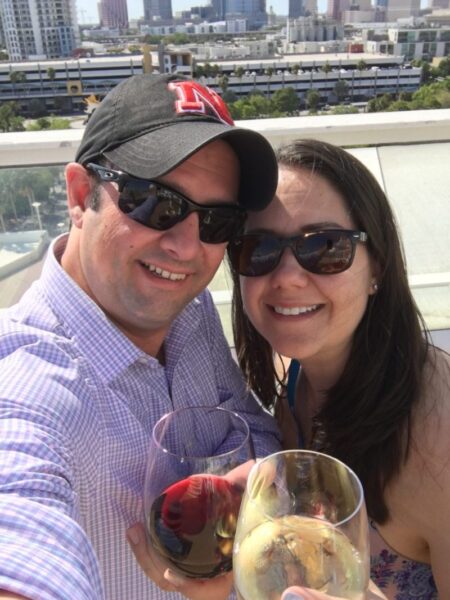
I did not always love wine. In fact, it really wasn’t until I started learning to pay attention to what I was tasting. I needed my own wine tasting for beginners lesson. I want to share what I learned with you!
Why do you want to learn to enjoy wine?
Maybe you find yourself with a close friend or significant other that loves wine, and you feel left out. Maybe you’re tired of buying all the items needed to make fancy cocktails (I was!). Perhaps you want to impress guests you invite to dinner. Whatever the reason is, you have come to the right place. If you’re really lucky, you’re traveling to some fantastic destinations known for wine and you want to study up a bit before you go. I will tell you how I went from wine hater to wine lover. You can follow the same path to discover wines you love as well.
Start at the Beginning
First, to figure out what kind of wine you might like, you have to TASTE WINE. Well, duh. Here are a few basic characteristics of wine and what they all mean. In this article you will learn about:
- Color
- Scent
- Texture
- Taste
It may seem like knowing these characteristics is just extra information that is only relevant to wine snobs. However, knowing the characteristics of wine you like can help you identify other wines without tasting them. For example, if you are shopping for wine for a party and the store is out of the specific wine you were looking for, you can choose another wine with similar characteristics. Chances are good that the wines will be close in taste and style. The more you know these basics, and take notes on what you do and do not like, the better you will be at navigating the endless selections available.
You can spend a lot of time learning about wine if you want to! Impress your friends, make amazing food pairings, or just start a new hobby. The possibilities are endless!
Pre Wine-lover life
Since I never really enjoyed beer or wine, cocktails were my adult beverage of choice. The fruitier and sweeter the better! I was frequently the only person in my group of friends that was drinking fancy cocktails. They were SO much more expensive which really matters when you’re in your early 20’s! I just couldn’t drink the cheap, bitter beer that was the choice of nearly everyone in my social circle. And none of my friends were really into wine… so mixed drinks it was.
I tried wine on more than one occasion and I always found it to be unappetizing. Red, white, or rosé, it didn’t matter. I was not a fan. I would, however, drink mimosas and bellinis assuming there was enough of the fruit juice or puree in them to make them pretty sweet. Are you sensing a theme here? Sweet, fruity…
I took a trip during my senior year of college to visit my good friend in Virginia. We planned a girls weekend complete with visits to 3 Virginia wineries. You see, many of my girl friends had started to actually like wine. I desperately wanted to understand what all the fuss was about. Looking back, it was a rather disappointing wine trip. We both really didn’t know what we were doing at the tastings, why we were doing it, or what we should be learning! We simply liked the wine, or not… and it was mostly NOT.
Finding the Right Wine Tasting Teacher
Fast forward to my first winter in New York City after I’d been living there almost a year with Travis. During that year, I’d been gradually trying wine – mainly when he’d order a glass and I’d have a sip or two. (I’d still normally order a cocktail…) It was obvious that Travis really enjoyed sharing with me and asking what I though with each new taste. I decided to plan a special trip for Travis’ birthday.
Long Island is one of the smaller wine regions in the US, and we were just a short drive away. I mapped out the whole weekend with stops at micro-breweries and wineries. I was going purely off reviews. It was the first time we went to a real wine tasting together. Travis took the time to explain why I was doing all the strange things I was doing. (More on those below.) It was the start of an amazing journey learning about wine – and wine that I liked!
Not only did Travis introduce me to the wines he liked, but we continued exploring more together. It truly amazes me all that I have learned in a few short years. All it took was the right person to take the time to teach me how to really appreciate wine.
Wine Tasting: the 5 S’s
I’m sure you’ve seen someone tasting wine before. They do all kinds of weird things like sniffing in the glass, slurping – complete with sound effects, and spitting wine out. GASP! It may look odd, but doing all of these things really allows you to discover the true nature and flavor of the wine.
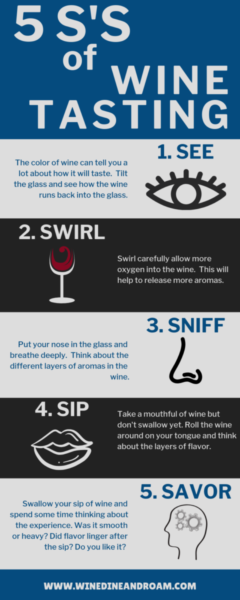
See
The Color of wine can tell you a lot about it. The best way to examine the color of wine is to hold your glass at an angle (about 45 degrees) over something white, like a napkin, in a well lit room. You will be able to see the true color and not be influenced by the other colors in the room.
Red wine colors range from an orangy-red color to a deep purple. Where as, white wine ranges from a pale straw color to deep amber or copper.
The color can help you identify the kind of grape, how much the wine has been aged, if and how long the skins were fermented with the juice, and many other characteristics. All of which, you guessed, can tell you something about the flavor.
Full-bodied might be a term you’ve heard before, but what does “bodied” mean? In the wine world, the body of the wine is described as light, medium, or full. It generally refers to the feeling of weight or fullness of the wine in your mouth. Full-bodied wines tend to be powerful or big, where light-bodied wines tend to be more crisp or delicate. Medium-bodied, well, they are just somewhere in the middle. There is no clear cut or defined point between them, it’s really up to the person and their perception. It is a spectrum, so wine could be considered light-to-medium, or medium-to-heavy. You can tell these differences just by the color! For example: a dark ruby colored wine may be full-bodied, where a light red may have a softer taste and be considered light bodied.
The age of the wine is another characteristic you can tell be examining the color. Red wine loses its color as it ages going from a rich red to more brown or copper tones. White wine does the opposite, it gains color going from a lighter yellow-green to darker yellow-copper.
Swirl
Before you smell the wine give it a good swirl. Careful, don’t spill! When learning to swirl your wine, or if you’re just clumsy like I am, set your glass on the table and move it gently in a circular motion to get the wine moving around.
Swirling the wine allows more oxygen to enter the glass and wine. Doing this will release more of the aromas of the wine. Some wines may have a strong scent before swirling, but can still release more aromas with a little oxygenation. It doesn’t matter the type. Red, white, or rose can all benefit form a good swirl. The exception to this would be older wines. You should treat them more delicately and allow them to “breathe” on their own for a few moments in the glass, or decanter. A decanter or Aerator is a great tool to have on hand if you are going to serve wine properly to guests, and get the most out of your own wine tasting experience.
Sniff
Go ahead! Really get your nose into the glass and breathe deeply. Try to identify what you smell. You will likely notice you smell more than one scent. There are over 200 aromas that are commonly found in wine. I know I’m not capable of identifying very many of them (what does currant smell like anyway…), but still try to pick out a few! You can learn to get better at recognizing more scents with practice.
Your sense of smell is critical in influencing the way things taste. Think about tasting anything. If you have a cold, your favorite foods don’t taste the same. Have you ever pinched your nose when you have had to take some gross flavored medicine? Although sometimes that still doesn’t help completely get rid of the taste, it can certainly dull it.
You can only actually taste 5 flavors – yes only 5! Go back to your elementary school days and think of the diagram of the tongue. Does it look something like this?
That being said, take the time to really think about what you smell before moving on to the next step!
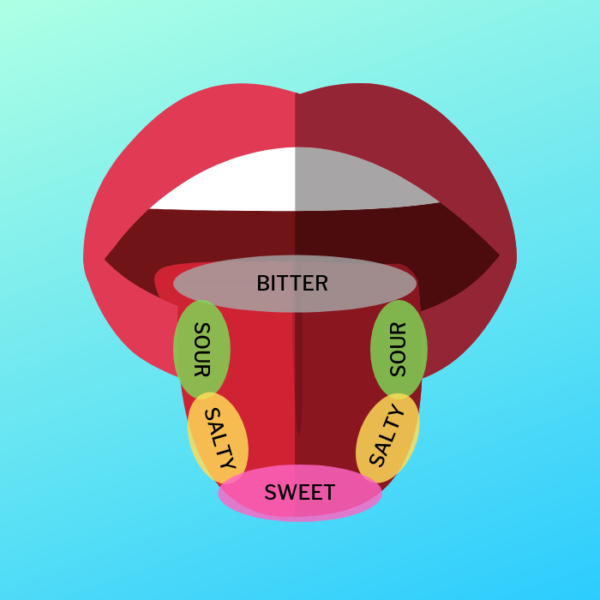
That being said, take the time to really think about what you smell before moving on to the next step!
Sip
Finally! You get to taste the wine!!
Take a sip. Not a small sip, like your scared to taste it, but a decent mouthful. For those of you that are like me and need more specific instructions, about a tablespoon or two. You will even hear some people slurp when they take a sip during a tasting. Remember the part oxygen plays in tasting I talked about earlier? Slurping isn’t rude when you’re tasting wine, it’s just about adding more oxygen!
Wait! Don’t swallow it yet. Allow the wine to coat your tongue and move it around in your mouth so all your taste buds can get in on the action. What do you taste? Start with big flavor groups: sweet, bitter, sour. Then, move on to more specific flavors: cherries, strawberries, green apple, lemon, etc.
Now, how does the wine feel in your mouth? Yes, wet… but is it thick and syrupy, or light and crisp? Wine with more tannins, typically reds, can cause your mouth to feel dryer. Meanwhile, wines with a higher alcohol content might make your mouth feel more warm.
Next, think about the flavors you taste. They may be similar to what you smelled, or you may find they are completely different. Don’t feel bad if you don’t taste the same thing as someone you’re tasting with or what you are ‘supposed to taste.” Just like someone that is color blind perceives colors differently from someone who is not color blind. Your taste buds and experiences are not the same as anyone else’s. That’s part of what makes tasting wine with friends so much fun!
Savor
Finally, swallow your sip of wine. Take time to reflect on what you’ve experienced. I like to try to think about what would taste good with the wine. Maybe some chocolate or a steak? Or maybe your favorite cheese. Even think about things that wouldn’t normally pair with wine like tacos! The possibilities are endless, and there is no right or wrong answer.
Continue on Your Journey to LOVING Wine
There is so much more to talk about when looking at what causes the wine to taste the way it does. Influences like the climate or farming practice where the grapes were grown or the way the wine is aged are just a few additional factors. Just remember to make note of what you like, and don’t like and even track the wineries or winemakers that you enjoy! For someone new to wine, this is a very good place to start your journey. Taste, reflect, repeat!
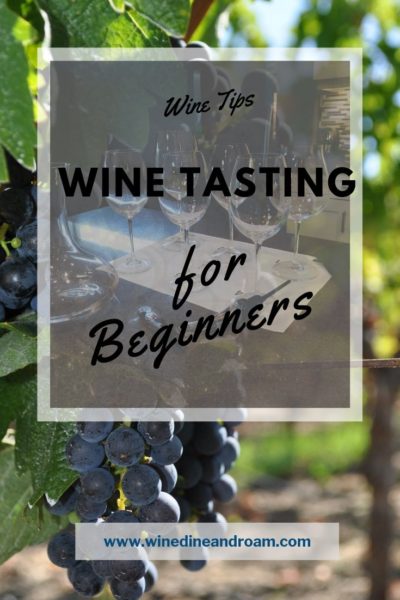
What is your favorite wine? Leave us a note in the comments!
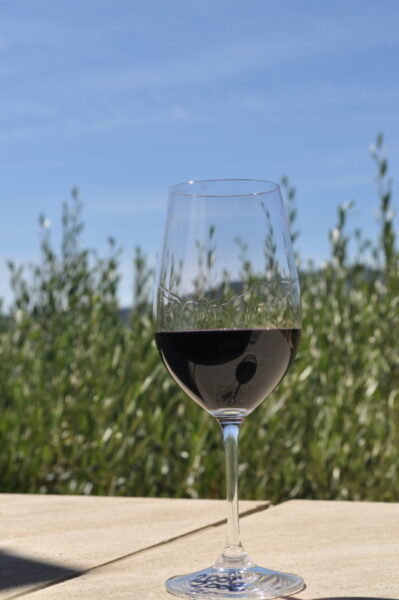
Love Wine? Check out our Napa Wineries post!

